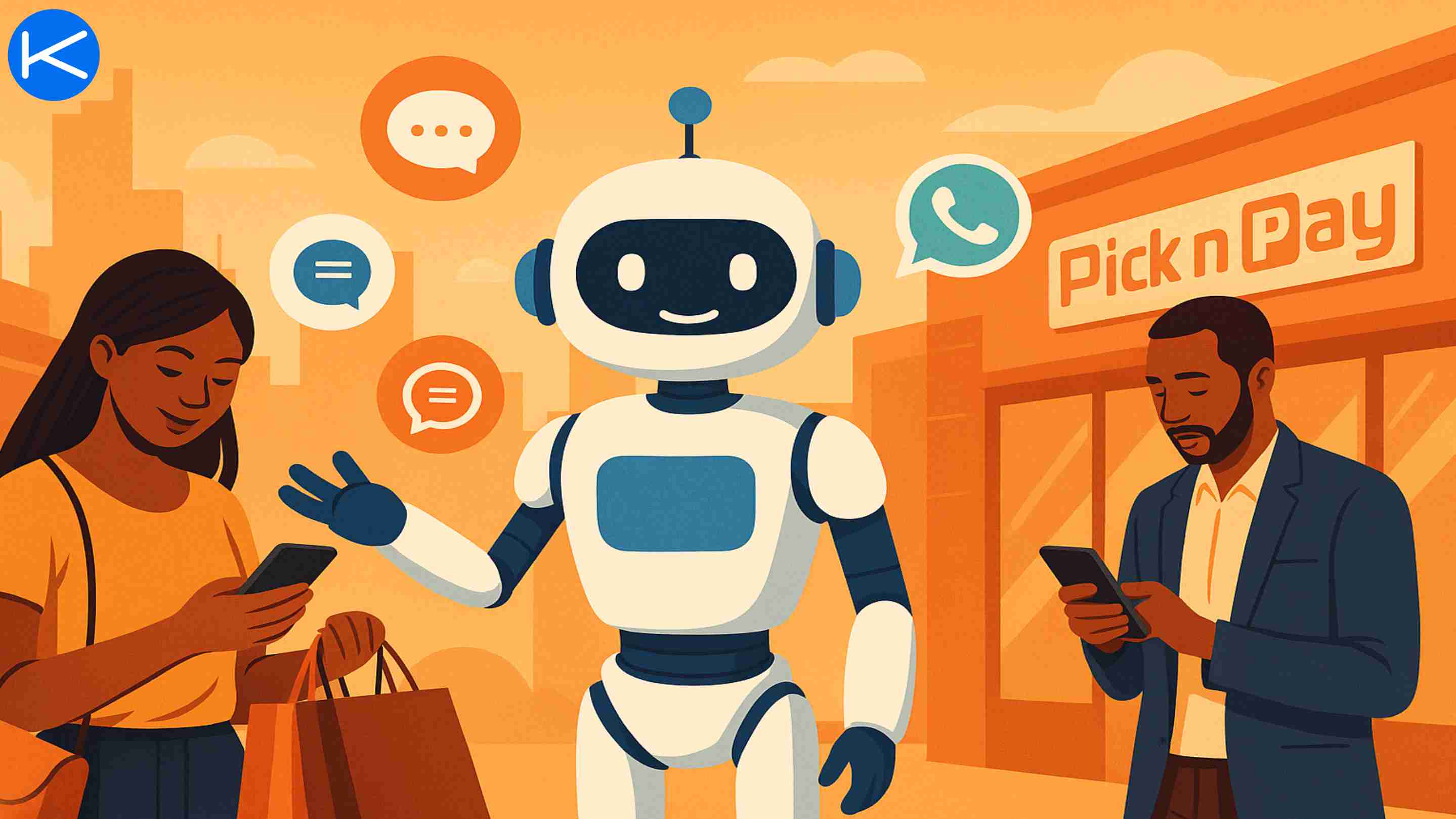Lethabo Moroka
1 year, 3 months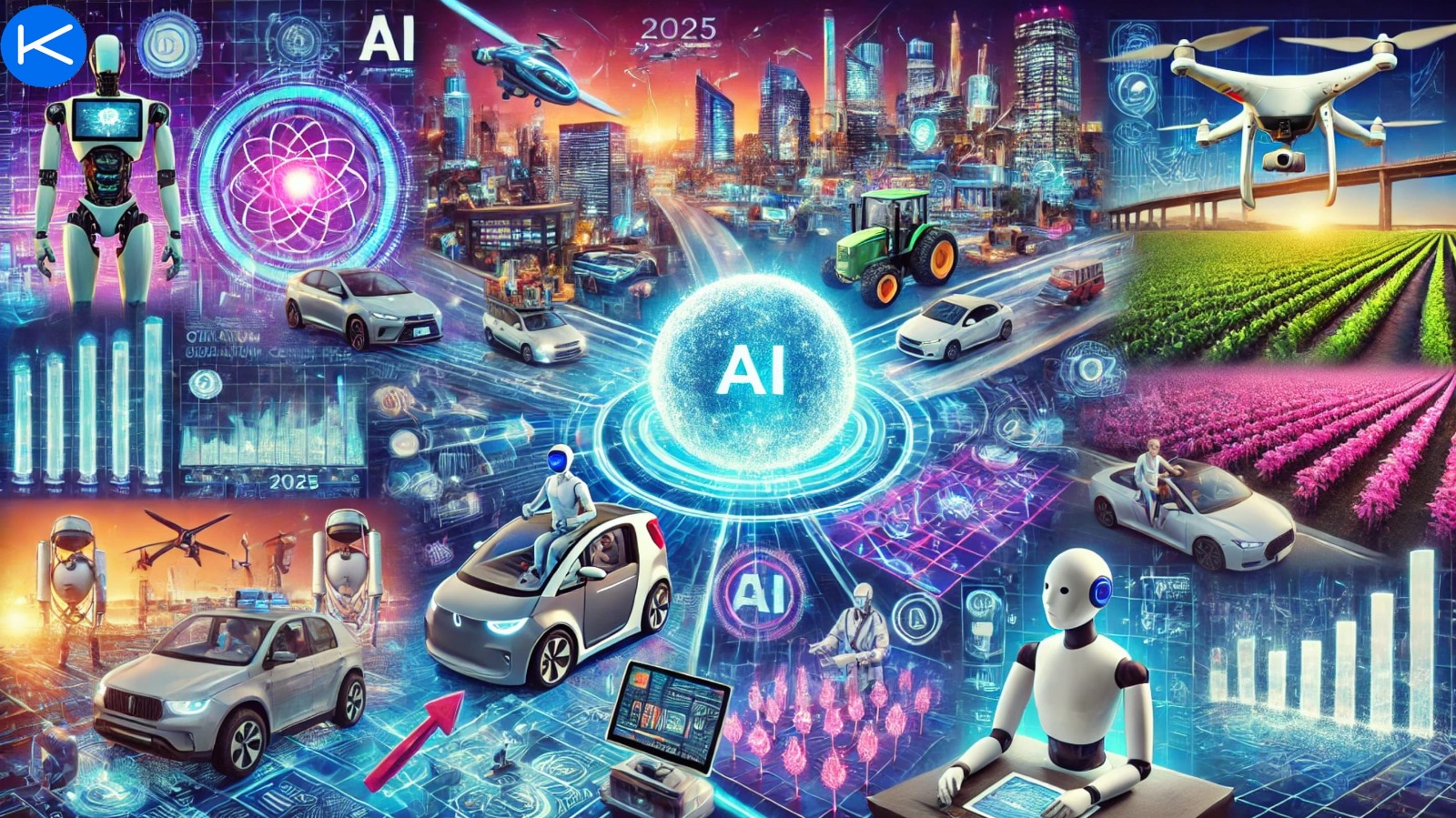
Top #7 AI Trends to Watch in 2025
If you thought AI was just a fancy way to make your smartphone camera smarter, buckle up—because 2025 is coming, and AI is about to go full superhero on us.
Artificial Intelligence is no longer just the stuff of sci-fi movies; it's rapidly becoming the backbone of industries around the globe. From boosting productivity to fighting off cyber threats, AI is changing the game, and it's doing it fast.
But what does 2025 have in store for this tech powerhouse? In this article, we’re diving into the top AI trends set to shape the future. And don’t worry, we’re not just throwing out buzzwords—we’ve got the data and expert opinions to back it all up. So, let’s get into it: here are the AI trends you need to watch in 2025:
- AI Chatbots Adoption
- AI-Driven Automation Across Industries
- The Surge in AI-Powered Cybersecurity Solutions
- AI’s Role in Healthcare Transformation
- Generative AI and Creativity Boom
- Growth of AI Ethics and Regulation
#1 AI Chatbots Adoption
As we move towards 2025, the use of chatbots is expected to expand significantly across various sectors, driven by advancements in artificial intelligence (AI) and changing consumer expectations. Chatbots, which have become integral to customer service and engagement strategies, are evolving to meet the demands of a more digital and automated world.
Key Trends in Chatbot Usage
- Increased Adoption Across Industries: The chatbot market is projected to grow from $5.4 billion in 2023 to $15.5 billion by 2028, reflecting a compound annual growth rate (CAGR) of 23.3%. This growth is fueled by the rising demand for 24/7 customer support and the need for businesses to reduce operational costs. Industries such as retail, healthcare, finance, and e-commerce are increasingly implementing chatbots to enhance customer interactions and streamline operations.
- Advancements in Natural Language Processing (NLP): The evolution of generative models, particularly those based on neural networks like GPT-4, is significantly enhancing chatbot capabilities. These advancements allow chatbots to better understand and respond to human language, making interactions more natural and engaging. As a result, chatbots will be able to provide more personalized recommendations and support, improving the overall customer experience.
- Self-Learning and Adaptive Chatbots: The development of self-learning chatbots that can adapt to changing conditions and learn from past interactions is on the rise. These chatbots utilize machine learning and NLP technologies to deliver more human-like conversational experiences. By analyzing user data and feedback, self-learning chatbots can provide contextually relevant information and improve their responses over time, leading to higher customer satisfaction.
- Integration with Messaging Platforms: As consumer preferences shift towards messaging applications, chatbots are increasingly being integrated into these platforms. This trend is expected to continue, as businesses recognize the importance of meeting customers where they are. Chatbots deployed on popular messaging apps can facilitate seamless interactions, making it easier for users to access services and support without leaving their preferred platforms. Like we have seen already with KaraboAI Chatbots, this chatbot builder platform allows you to integrate your chatbot with Whatsapp, click here to read more about it.
- Enhanced Personalization: Chatbots will increasingly leverage data analytics to offer personalized experiences. By analyzing user behavior and preferences, chatbots can tailor interactions to meet individual needs, resulting in more effective communication and engagement. This trend is particularly important as consumers expect brands to deliver customized experiences that resonate with their interests.
- Focus on Customer Experience: The emphasis on improving customer experience will drive chatbot development in 2025. Businesses are recognizing that efficient and effective customer service is crucial for retaining customers and building brand loyalty. Chatbots will play a vital role in addressing customer inquiries quickly, reducing wait times, and providing instant support, which is increasingly important in a fast-paced digital environment.
Get started with your very own AI powered chatbot with Karabo today: How to create an AI chatbot with KaraboAI
#2 AI-Driven Automation Across Industries
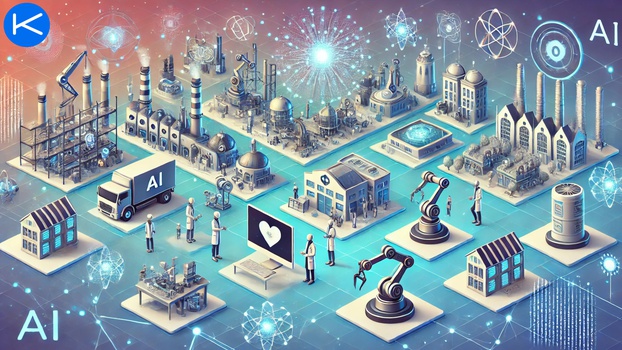
Artificial Intelligence (AI) is fundamentally transforming various sectors by enhancing efficiency, accuracy, and operational capabilities. Industries such as manufacturing, retail, and logistics are leveraging AI-driven automation to streamline processes, reduce costs, and improve customer experiences.
Overview of Automation in Key Sectors
- Manufacturing: AI is revolutionizing manufacturing by automating routine tasks and enabling predictive maintenance. For instance, AI algorithms can predict equipment failures before they occur, minimizing downtime and optimizing production schedules. According to McKinsey, companies that adopt AI-driven supply chain management can achieve a 15% reduction in costs and a 35% decrease in inventory levels.
- Retail: In the retail sector, AI-driven automation is crucial for enhancing supply chain efficiency and customer satisfaction. Intelligent inventory management systems utilize AI to predict demand accurately, allowing retailers to optimize stock levels and reduce waste. Research indicates that 80% of supply chain executives plan to implement some form of automation within the next two years, with the potential to boost revenue growth by 10% annually.
- Logistics: AI is reshaping logistics by streamlining operations across order processing, inventory management, and distribution. AI tools analyze vast amounts of data in real-time, enabling companies to optimize route planning and improve delivery efficiency. For example, AI can reduce supply chain errors by 20-50%, significantly enhancing service levels and customer satisfaction.
- Finance: The finance sector is increasingly leveraging AI to automate processes and enhance decision-making. AI technologies are being used for tasks such as credit scoring, fraud detection, and risk management. According to a report, the market value of AI in finance was estimated at $9.45 billion in 2021 and is expected to grow at a rate of 16.5% by 2030
Specific Use Cases of AI Automation
- Warehouse Automation: AI technologies are increasingly used in warehouses to automate tasks such as picking, sorting, and inventory management. For example, House of Fraser has integrated 5,000 intelligent robots into its warehousing operations, enabling faster order processing and improved accuracy. These robots can handle heavy lifting, allowing human workers to focus on more strategic tasks.
- Supply Chain Optimization: AI-driven solutions break down data silos within supply chains, allowing for better communication and coordination among various functions. By integrating data from sales, inventory, and shipping, AI can facilitate faster and more accurate ordering and fulfillment processes.
- Predictive Maintenance: In manufacturing and logistics, AI systems can predict when machinery is likely to fail, allowing for timely maintenance and reducing unexpected downtimes. This capability not only saves costs but also enhances overall operational efficiency.
- Applications: AI helps streamline operations by automating data analysis and reporting, allowing financial professionals to focus on strategic tasks. For instance, AI can analyze transaction patterns to detect fraudulent activities in real-time, significantly improving security measures. Companies like Kensho Technologies and Scienaptic AI are leading the way in applying AI for credit decisions and financial risk management.
#3 The Surge in AI-Powered Cybersecurity Solutions

AI is revolutionizing cybersecurity by enabling more proactive threat detection and response mechanisms. As cyber threats become increasingly sophisticated, organizations are turning to AI to enhance their security measures. According to Gartner, the AI cybersecurity market is expected to grow to $134 billion by 2025, driven by the increasing need for advanced security solutions.
How AI is Transforming Cybersecurity
AI technologies are being integrated into cybersecurity frameworks to improve the speed and accuracy of threat detection. By analyzing vast amounts of data in real-time, AI systems can identify anomalies and potential threats that traditional security measures might miss. This proactive approach allows organizations to respond to threats more quickly, reducing the potential impact of cyberattacks.
Examples of AI Tools in Cybersecurity
- Darktrace: Darktrace utilizes machine learning to detect anomalies in network behavior. Its self-learning technology allows it to identify and respond to threats in real-time, providing organizations with a robust defense against cyberattacks. Darktrace's approach is particularly effective in identifying insider threats and advanced persistent threats (APTs).
- CrowdStrike: CrowdStrike employs AI to analyze vast amounts of data from endpoints, which helps in identifying potential breaches before they occur. Its Falcon platform uses AI to provide insights into threat intelligence, enabling organizations to strengthen their security posture and prevent future attacks.
Market Growth and Future Outlook
The AI-powered cybersecurity market is experiencing rapid growth. According to MarketsandMarkets, the market size was valued at $22.4 billion in 2023 and is projected to grow at a compound annual growth rate (CAGR) of 21.9%, reaching $60.6 billion by 2028. This growth is driven by the increasing adoption of real-time threat detection solutions and the need for automation in cybersecurity processes.
The rise in cyberattacks, particularly on high-tech companies, government agencies, and financial institutions, underscores the urgent need for advanced AI solutions. As organizations face a growing volume and complexity of cyber threats, the demand for AI-driven cybersecurity tools will continue to rise.
#4 AI’s Role in Healthcare Transformation
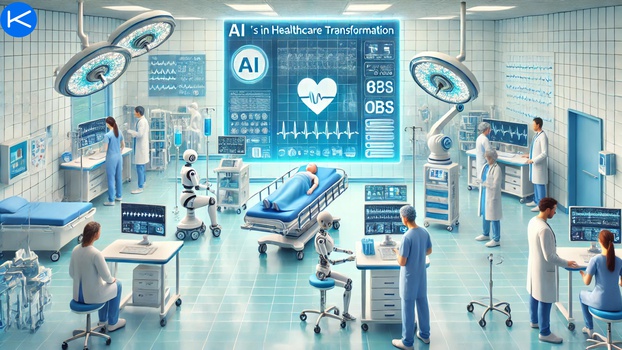
Artificial Intelligence (AI) is significantly impacting the healthcare sector through advancements in predictive analytics, diagnostics, and robotic surgery. The World Economic Forum reports that AI could save the healthcare industry $150 billion annually by 2026 through improved efficiencies. This transformation is reshaping how healthcare providers deliver care, manage resources, and engage with patients.
Applications of AI in Healthcare
- Predictive Analytics: AI-driven predictive analytics utilizes vast datasets, including electronic health records (EHRs), imaging, and genetic data, to forecast patient outcomes and improve decision-making. By identifying patterns and correlations within the data, AI algorithms can predict disease progression and optimize treatment plans, enhancing personalized medicine. For instance, predictive models can identify high-risk patients, enabling early intervention and tailored treatment strategies.
- Example: A study highlighted in the literature review from the National Institutes of Health emphasizes that AI predictive analytics can significantly improve patient outcomes by forecasting disease progression and treatment responses. These capabilities are crucial for enhancing clinical decision-making and healthcare delivery .
- IBM Watson: IBM Watson leverages AI to assist healthcare professionals in diagnosing diseases by analyzing extensive patient data and medical literature. By providing actionable insights, Watson helps clinicians make informed decisions, improving diagnostic accuracy and treatment efficacy. This tool exemplifies how AI can augment human judgment in medical practice, leading to better patient care.
- Robotic Surgery: AI-powered robotic systems are transforming surgical procedures by enhancing precision and reducing recovery times. These systems assist surgeons in performing complex operations with greater accuracy, leading to improved patient outcomes. The integration of AI in robotic surgery not only minimizes the risk of complications but also shortens hospital stays, contributing to overall healthcare efficiency.
- Example: Robotic systems, such as the da Vinci Surgical System, utilize AI to assist in minimally invasive surgeries, allowing for more precise movements and better visualization during operations. This technology has been shown to reduce postoperative pain and accelerate recovery times for patients.
Impact on Healthcare Costs and Efficiency
The implementation of AI technologies in healthcare is expected to yield substantial cost savings. The World Economic Forum's report indicates that AI could lead to a $150 billion reduction in healthcare expenditures by 2026, primarily through enhanced operational efficiencies and improved patient management.
- Cost-Saving Potential: AI-driven predictive analytics can help reduce hospital readmissions by identifying patients at risk of complications and ensuring they receive appropriate follow-up care. This proactive approach not only improves patient outcomes but also decreases healthcare costs associated with readmissions.
#6 Generative AI and Creativity Boom
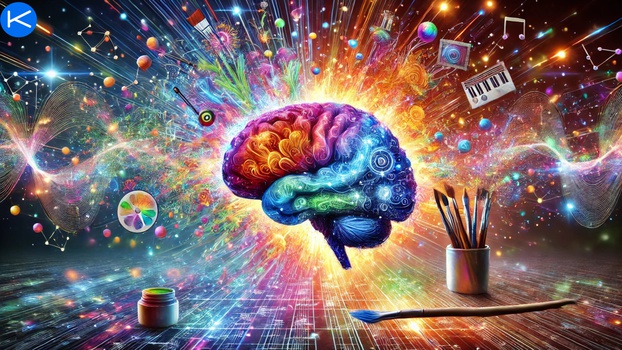
Generative AI tools are revolutionizing content creation across various industries, enabling creators to produce high-quality content with unprecedented efficiency. According to Forbes, the use of generative AI in content production is expected to increase by 30% in the coming years, reflecting the growing reliance on these technologies to enhance creativity and productivity.
Tools and Uses
- DALL-E: DALL-E, developed by OpenAI, is a cutting-edge AI model that generates images from textual descriptions. This tool allows artists and designers to create visual content more efficiently by transforming complex text prompts into unique images. DALL-E has evolved through several iterations, with DALL-E 3 being the latest version, which significantly improves the coherence and detail of generated images compared to its predecessors.
- Capabilities: DALL-E can not only create images but also edit and adjust existing ones based on user input. It understands nuanced descriptions, enabling users to generate highly specific and imaginative visuals. For instance, if a user inputs a prompt describing a "futuristic cityscape at sunset," DALL-E can produce a detailed image that captures that vision accurately.
- Applications: DALL-E is being used in various fields, including advertising, art, and education, where it aids in creating illustrations, product designs, and educational materials without requiring advanced artistic skills.
- OpenAI’s GPT Models: The Generative Pre-trained Transformer (GPT) models, including the latest GPT-4o, showcase significant advancements in natural language processing. Each new iteration of GPT has demonstrated enhanced capabilities in understanding context, generating coherent text, and assisting in creative writing tasks.
- Model Growth: With each new model release, OpenAI has improved the architecture and training processes, leading to better performance in generating human-like text. GPT-4o, for example, has shown remarkable improvements in handling complex prompts and generating contextually relevant responses, making it an invaluable tool for writers, marketers, and content creators.
- Applications: GPT models are widely used for content generation, including articles, marketing copy, and even creative storytelling. They empower users to brainstorm ideas, refine their writing, and produce high-quality content rapidly.
The Impact of Generative AI on Creativity
The rise of generative AI tools like DALL-E and GPT models is fostering a creativity boom across industries. By automating parts of the creative process, these tools allow creators to focus on higher-level conceptual work rather than getting bogged down in technical details. This shift not only enhances productivity but also democratizes creativity, enabling individuals without formal training to produce professional-grade content.
#7 Growth of AI Ethics and Regulation

As artificial intelligence (AI) technologies proliferate, there is an increasing focus on ethical AI practices and government regulation. According to a prediction by the Harvard Business Review, 75% of organizations are expected to have implemented AI ethics guidelines by 2025 to ensure the responsible use of AI systems.
Impact of Regulations
- Transparency and Accountability: Regulations will require businesses to ensure transparency and accountability in their AI systems, affecting how developers design and implement these technologies. Companies will need to prioritize explainable AI, where the decision-making process of AI models is interpretable and understandable to users.
- Data Privacy and Algorithmic Bias: Organizations will face scrutiny regarding data privacy and bias in their AI algorithms. This will prompt a shift towards more ethical practices in AI development, such as using diverse and representative datasets to train AI models and conducting regular audits to identify and mitigate biases.
Regulatory Frameworks
Governments around the world are developing regulatory frameworks to govern the use of AI and ensure ethical practices. For example:
- The European Union has proposed the Artificial Intelligence Act, which aims to establish harmonized rules for the development, marketing, and use of AI systems in the EU.
- The United Kingdom requires clinical decision support software to obtain approval from the Medicines and Healthcare Products Regulatory Agency. Developers must demonstrate that the benefits outweigh the risks, the software's effectiveness, and adherence to standards.
- The United States Food and Drug Administration has issued draft guidance for clinical decision support systems that use AI.
- Canada is considering regulatory requirements for AI as a medical device and is beginning to develop frameworks to safeguard the health of its citizens.
Ethical Guidelines
In addition to government regulations, organizations are also developing their own ethical guidelines for the use of AI. For instance:
- UNESCO has adopted the "Recommendation on the Ethics of Artificial Intelligence," which provides a global standard on AI ethics based on the advancement of fundamental principles such as transparency, fairness, and human oversight.
- ZF, an automotive technology company, has created "Ethics Guidelines for Trustworthy AI" to ensure the sustainable and ethically acceptable use, development, and application of AI technology.
- Bosch has established ethical "red lines" for the use of AI, emphasizing that humans should be the ultimate arbiter of any AI-based decisions and that AI should be a tool for people rather than making decisions without human oversight.
Final Thoughts
As we look ahead to 2025, the landscape of artificial intelligence (AI) is poised for transformative growth across various sectors. The advancements in AI technologies are not only enhancing operational efficiencies but also reshaping how we live and work. From personalized healthcare solutions to AI-driven automation in industries like manufacturing, retail, logistics, and finance, the potential applications of AI are vast and varied.
In conclusion, the future of AI is bright and full of potential. By 2025, we can expect AI to be deeply embedded in our lives, making tasks easier and more efficient while driving economic growth and innovation. As we embrace these advancements, it is imperative to steer the development of AI in a direction that benefits all of society, ensuring that the technology serves as a force for good in our increasingly digital world. The journey ahead is exciting, and it is up to us to shape it responsibly.

